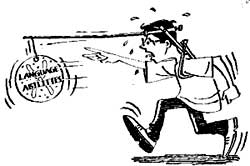Speakeasy
 talking, for most of us, comes naturally. But how we develop this ability for verbal communication had many experts guessing. But not any more. For the first time, scientists and geneticists are hot on the trail of a gene that shapes the development of human language. They hope that this startling new discovery may one day help e x plain why many speech and language disorders arise. Scientists tell us that our genetic heritage can strongly affect our ability to communicate. Identical twins, for instance, often tend to share a common linguistic ability or disability.
talking, for most of us, comes naturally. But how we develop this ability for verbal communication had many experts guessing. But not any more. For the first time, scientists and geneticists are hot on the trail of a gene that shapes the development of human language. They hope that this startling new discovery may one day help e x plain why many speech and language disorders arise. Scientists tell us that our genetic heritage can strongly affect our ability to communicate. Identical twins, for instance, often tend to share a common linguistic ability or disability.
For years, numerous geneticists have tried to hunt down and locate the genes that influence our language abilities by studying linguistic disorders that are essentially inherited. Stuttering, for example, is a disorder that runs in the family. However, such speech impediments tend to have complex patterns of inheritance, thus suggesting that not one, but multiple genes are involved in the entire process. And each of them, e x perts claim, make a substantial contribution. So far, they have not been able to snare a single solid candidate ( New Scientist , Vol 157, No 2119).
However, according to the latest reports, some British scientists have claimed that they are very close to identifying a gene that they have named spch 1 . These scientists report that after only si x months of work, they have narrowed their search to a small section of human chromosome 7. "This is a very good place to land,' says Anthony Monaco, a geneticist at the University of O x ford. "It's a well-mapped area, so the rest of our work should go quickly.'
The advance has been possible only because of an unusual family that the scientists refer to as " ke' . Over a decade ago, members of this family arrived at the Institute of Child Health in London, uk , complaining that some of their relatives had a rather strange speech impediment. "What strikes you first is the fact that their speech in near-unintelligible,' observes Faraneh Vargha-Khadem, a neuropsychologist at the institute, who inspected the family's peculiar speech disorder.
The affected relatives of the ke family soon proved to have deficits in all aspects of speech, and severe difficulty in coordinating some facial muscles when talking. The afflicted children also had problems while mastering basic reading and writing skills. But what really singled out the ke disorder was its simple pattern of inheritance. Further genetic analysis showed that only a single, dominant mutation was responsible for the disorder. The researchers could successfully trace this mutation back to the family's grandmothers.
Vargha-Khadem and her colleagues collaborated with Monaco's team to locate the defective gene. They analysed numerous chromosome segments, thinking that the members with the impediment should share the grandmothers' version of the regions. Two closely-spaced segments of chromosome 7 showed a perfect match: they were present in 15 linguistically impaired relatives and 12 healthy ones.
And according to Monaco, this means that spch 1 has to lie very close by. His team also notes in research that is yet to be published that the same region on chromosome 7 also plays a part in autism, another linguistic impediment. "This suggests we are going to be helped a lot by knowing how this particular gene functions, and what role it plays in other disorders,' says Vargha-Khadem.
"It's e x citing to think that we are going to start studying something as incredibly sophisticated as language gene by gene,' says Dennis Drayna of the National Institute of Deafness and other Communication Disorders in Washington, usa . "The paper may be a small step, but it will have huge implications,' he reassures.
